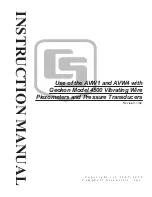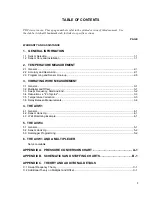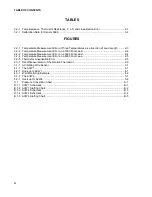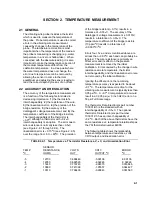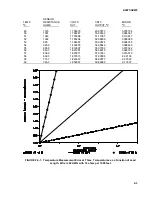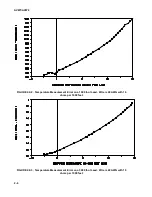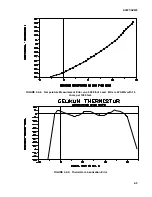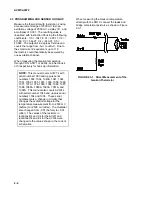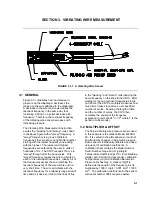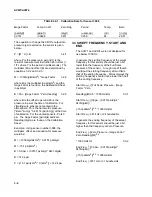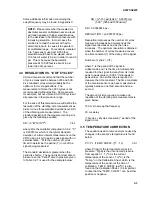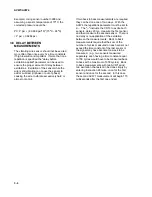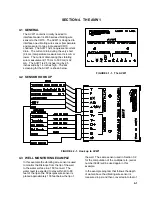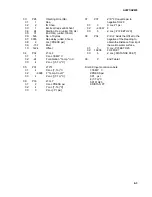
1-1
USE OF THE AVW1 AND AVW4 WITH GEOKON MODEL 4500
VIBRATING WIRE PIEZOMETERS AND PRESSURE TRANSDUCERS
1. GENERAL INFORMATION
The CR10 is the only CSI datalogger that has
the capability of measuring the vibrating wire
pressure sensor in addition to the piezoresistive
type of strain gage sensor. The CR10 can
measure vibrating wire sensors with short leads
without the AVW1 or AVW4. However, the
AVW1 and AVW4 provide important signal
conditioning that 1) completes the thermistor
bridge for the measurement of the sensor's
temperature, 2) converts the swept frequency
excitation from 2.5 volts peak to peak to 12
volts peak to peak, 3) provides transformer
isolation and consequent noise reduction for the
vibrating wire signal, and 4) provides additional
transient protection for both the temperature
and vibrating wire circuits.
The AVW1 and AVW4 are designed and tested
over the environmental range from -25
°
C to
+50
°
C. CSI recommends that special
temperature testing be done at the factory if the
AVW's are to operate at temperatures outside
this range.
The vibrating wire pressure sensor has a good
reputation for long term stability. The sensor
utilizes a change in the frequency of a vibrating
wire to sense pressure. Two measurements
are usually made on a vibrating wire sensor.
The first is the measurement of the temperature
of the probe to compensate for changes in its
temperature. The second is the measurement
of the frequency of the vibrating wire.
This manual covers the use of the CR10 and
AVW1 or AVW4 with Geokon's Model 4500
vibrating wire sensor series. Sections 2 and 3
of this manual cover the temperature and
vibrating wire measurements respectively.
Sections 4 and 5 give detail concerning the use
of the AVW1 and AVW4.
Geokon includes a calibration sheet and
instruction manual with each sensor or group of
sensors they sell. Geokon's manual should be
consulted for information on sensor selection
and installation. Geokon's address and phone
number are: 48 Spencer Street, Lebanon, NH
03766, (603) 448-1562.
1.1 SENSOR SELECTION
The vibrating wire sensors may be purchased
as either vented or sealed sensors. The vented
sensors have a small hollow "vent tube" that
connects the hollow chamber behind the
diaphragm to the atmosphere. The vent tube
allows the barometric pressure to act on both
sides of the diaphragm equally which removes
the barometric pressure from the reading. A
pressure reading with out a barometric pressure
component is referred to as "gage" pressure. A
pressure reading with a barometric pressure
component is referred to as "absolute"
pressure. One disadvantage of the vented
sensor is that the cable, which contains the vent
tube, is more expensive than the cable for the
unvented sensor. For this reason, it may be
more economical to buy unvented sensors and
use an extra one as a barometer to remove the
barometric pressure. A second small
disadvantage of the vented sensors is that they
require the use of desiccant, which must be
changed periodically, to dry the air entering the
vent tube.
1.2 SENSOR CARE AND INSTALLATION
The moisture trap of the vented models should
be kept closed until readings are to be taken.
DO NOT FORGET to remove the screw that
plugs the moisture trap when readings are to be
taken.
The large diameter diaphragm used in the low
pressure sensor requires special care when
handling. Avoid bumping or jarring the sensor.
Orientation of the 4500 series sensors will affect
the zero reading. Readings should be taken
with the sensor in the same orientation at all
times. When installing the 4500 series sensors,
certain steps should be followed to obtain
proper zero readings.
The cavity between the sintered filter cap and
the diaphragm should be filled with clean water
without any air bubbles.
In most cases the sensor is made to output
water height or pressure relative to a measured
level. In this case the pressure sensor should
Summary of Contents for AVW4
Page 20: ...AVW1 AVW4 4 4 This is a blank page ...
Page 24: ...AVW1 AVW4 5 4 This is a blank page ...
Page 25: ...A 1 APPENDIX A PRESSURE CONVERSION CHART ...
Page 26: ...This is a blank page ...
Page 27: ...B 1 APPENDIX B SCHEMATICS AND STUFFING CHARTS FOR AVW1 AND AVW4 ...
Page 28: ...APPENDIX B SCHEMATICS AND STUFFING CHARTS FOR AVW1 AND AVW4 B 2 ...
Page 29: ...APPENDIX B SCHEMATICS AND STUFFING CHARTS FOR AVW1 AND AVW4 B 3 ...
Page 30: ...APPENDIX B SCHEMATICS AND STUFFING CHARTS FOR AVW1 AND AVW4 B 4 ...
Page 31: ...APPENDIX B SCHEMATICS AND STUFFING CHARTS FOR AVW1 AND AVW4 B 5 ...
Page 32: ...APPENDIX B SCHEMATICS AND STUFFING CHARTS FOR AVW1 AND AVW4 B 6 This is a blank page ...
Page 34: ...This is a blank page ...
Page 35: ...This is a blank page ...

